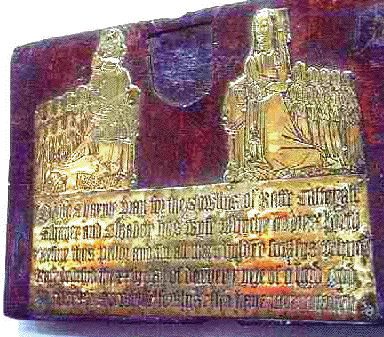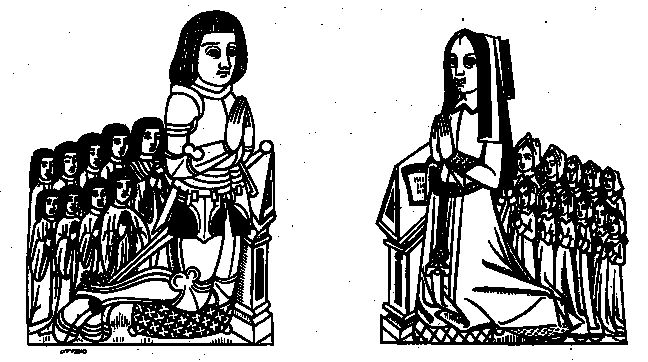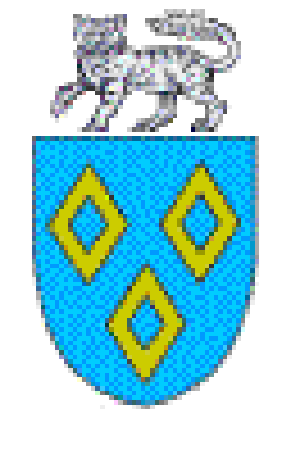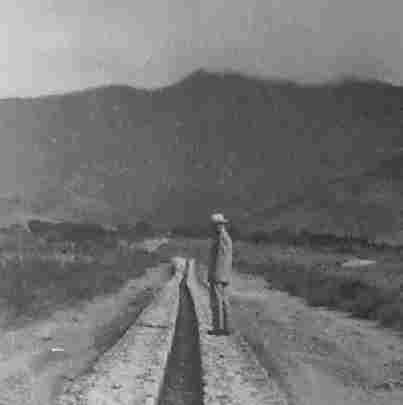The Catteralls are an old family, traceable back to about 930 ad. There is a memorial brass in Whalley parish church to the memory of Ralph and Elizabeth Catterall and their 9 sons and 11 daughters of the early 16th. century. (Elizabeth must have had a hard but very satisfying life.)
The photo is not too clear, so here is a drawing and a transcription.
Of yor Charyte pray for the Sowllys of Raffe Catterall',
Esquyer, and Elizabeth hys wyfe, whyche bodies lyeth
Before this Pellor, and for all' ther Chyldēr sowlys, whych
Rafe descesyd the xxvj day of decēber ye yere of or Lord god
M°ccccc°xv. On whose sowlys Jhū haue mercy amen.
In modern English this is: “Of your charity pray for the souls Of Ralph Catterall Esq. and his wife, Elizabeth, whose bodies lie before this pillar, and for all their children's souls. Ralph died on the 26th. day of December in the year of our Lord God 1515. On all their souls may Jesus have mercy. Amen”
This brass is now fixed to the northern wall, above a pew, at the entry to the Little Mitton chantry of Whalley parish church. Alan de Catterall gained the manor of Little Motton in 1310 on his marriage to Lora de Pontchardon, he retained the manor of Catterall, but moved the main residence to Little Mitton. The new manor houuse at Little Mitton, built about 1490, still exists and the main hall is almost unchanged. It is still almost in the family, owned by a distant cousin - his great grandmother and my great grandfather were brother and sister. Lora, with a long-living family dislike of paying taxes, set the dogs on the Abbot of Whalley when he came to collect. The Little Mitton manor estate lies adjacent to Whalley Abbey and there were long disputes about property. The brass once held the Catterall coat of arms, but that disappeared long ago. The coat of arms (see below) which was attached to the brass has never been found.
Our motto is “ Quod tuum tene ”, roughly “hold on to what is your own”…something the family failed to do when Queen Elizabeth I (1558-1603) persecuted the old catholic families.
In Whalley Parish church, the chantry at the head of the south aisle was appropriated to the Abbey, that on the north to the manor of Little Mitton. From 1310 the manor of Little Mitton was held by the Catterall family, and remained in their possession until the time of Queen Elizabeth I when, in order to avoid forfeiture to the crown, it passed to the Sherburne family of Stonyhurst on the marriage of Dorothy, 4th. daughter of Sir Thomas Catterall, a grandson of Ralph, to Robert Sherburne, 3rd. son of Sir Thomas Sherburne. So the family money eventually went to the foundation of the great Jesuit school of Stonyhurst. The school still has a 'Catterall Hall'.
The Catterall brass was removed from the church at the time of the Dissolution of the Monasteries in the reign of Henry VIII, and was in the possession of Robert Sherburne in 1659. The brass then disappeared until about 1820, when it was found at Catterall Hall by the Rev. Thomas Dunham Whitaker. It was then in the possession of Sir John Shelley, whose wife claimed descent from the Catteralls of Little Mitton. With Sir John's permission, the brass was restored to the Little Mitton chantry of Whalley church. At the entrance to the chantry is a stone commemorating the last abbot of Whalley, John Paslew who was executed at Lancaster in 1537 after supporting the Pilgrimage of Grace.
The seating in the parish church at Whalley was decided in 1534 when Sir John Towneley declared: "My man Shuttleworth, of Hacking, made this form, and here I will sit when I come, and my cousin Nowell may make one behind me if he please, and my sonnne Sherburne shall make one on the other side, and Mr. Caterall another behind him; and for the residue the use shall be, first come first speed, and that will make the proud wives of Whalley rise betimes to come to church."
Towneley's wife was Anne Catterall, a daughter of the Sir Ralph of Little Mitton depicted in the brass. Another daughter, Grace, was married to a Nowell of Read, and yet another daughter, Katherine was married to Henry Shuttleworth of Hacking. Dorothy, a great-granddaughter of Ralph and heir of his grandson, Thomas, was later to marry Robert Sherburne, and Mitton Hall passed to the Sherburnes who eventually forfeited all to the crown. Dorothy returned to Mitton Hall when she was married a second time to Richard Braddyll who had bought Mitton Hall from the crown.
In 1569, Thomas Talbot of Bashall, from across the river Ribble, described the window of Whalley church as containing "Orate pro animabis Radulphi Caterall armigeri et Elizabeth, uxoris sue, ac Johannis Cateral et Catherine, uxoris sue." Thomas, son of Johannis, was one of the primary recusants of “largest obstinacy” listed in 1575: ”Thomas Catterall and his wief” along with Anne Towneley, wief of Henry Towneley”. This Anne Towneley was a daughter of Thomas. A final note is added to the list: “if these could be reclaimed we think the others would follow.” Thomas died in 1579, but in 1581, Towneley was fined, arrested and imprisoned, first in Manchester, then London. Although the fines were paid, and he could no longer be justly committed, it was felt he “could do less mischief in London than in Lancashire.”
Another Catterall relative, Brother John-Paul of Mount St. Bernard Abbey near Leicester in England, traced the family links through the Gillow family of Lancaster to Eulogio Gillow (1841-1922), the first Archbishop of Oaxaca. D.H.Lawrence modeled the Bishop Severn in his novel "The Plumed Serpent' very closely on Gillow. In 1924 Lawrence came to Oaxaca and even to San Felipe, when there was very little there except the aqueduct supplying the city below with water.



